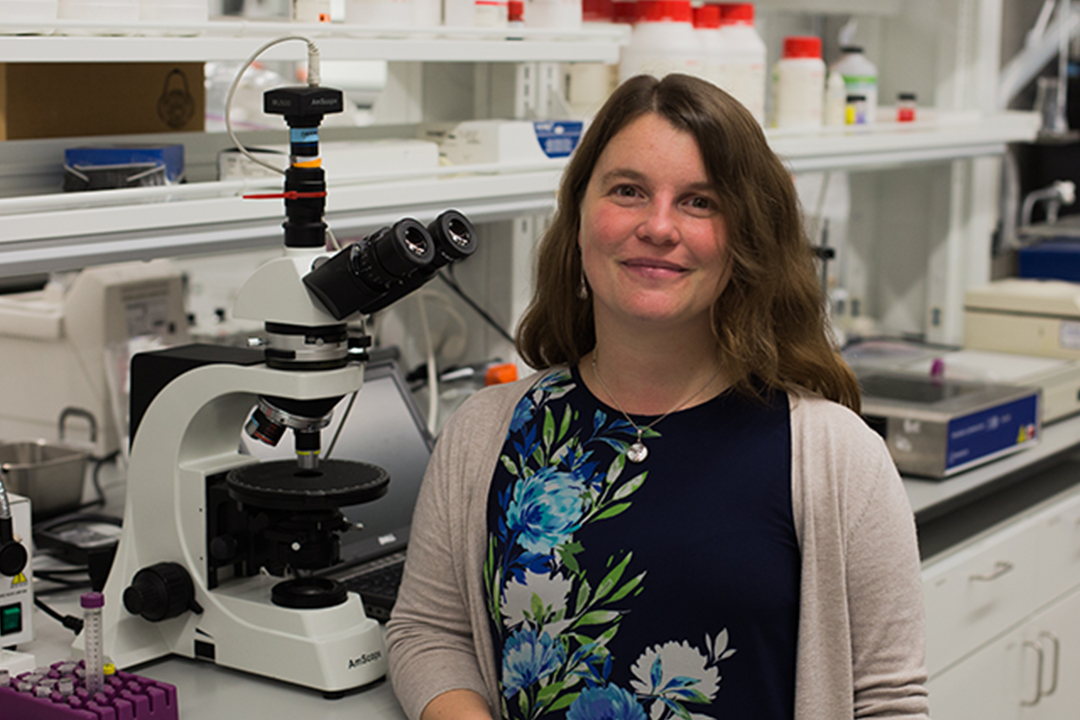There’s big news in the tiny world of the proton—a mystery so scandalous that it has divided the scientific community and threatened to upend everything we know about physics. “To call it a giant fuss is an understatement,” said CCAS Associate Dean and Associate Professor of Physics Evangeline J. Downie.
The proton, the plentiful particle that makes up much of the visible matter in the universe, may be smaller than scientists have long believed—specifically 4 percent smaller or a distance about a trillionth the width of a poppy seed. That infinitesimally tiny degree has sent scientists “running in circles,” Downie said. Despite careful analysis and re-analysis, no one can figure out why the proton seems to have shrunk.
“The proton makes up about 50 percent of all observable matter and we aren't sure how large it is,” Downie said. “That’s huge.”
Backed by funding from the National Science Foundation, Downie and an international team of 45 scientists, including CCAS Professors of Physics William J. Briscoe and Andrei Afanasev, are on a mission to crack what’s become known as the “Proton Radius Puzzle.” Begun in 2012, their ground-breaking experiments are heading into the home stretch—and their results may herald a fundamental new theory of physics. “We are the missing piece to the puzzle,” Downie said.
Inside the Proton
Protons are a cornerstone of centuries of science. The positively charged particles in the nucleus of every atom, they formed just millionths of a second after the Big Bang. Protons generate heat in the core of the sun, whiz through space as cosmic rays and are fundamental components of virtually all of the matter around us. Even small shifts in our understanding of them could have large-scale implications.
Protons are too small to be measured directly. Instead, scientists devised two methods for determining the particle’s radius. One is electron scattering: firing a beam of negatively charged electrons at a hydrogen atom and measuring the scattering angle as the individual electrons deflect off the nuclei’s lone proton. The second involves jolting an electron with energy—or “exciting” it—to kick the particle between orbits within the hydrogen atom. By measuring the exact frequency of the laser that propels the electron between orbits, scientists can determine their energy difference and estimate the proton's size.
Historically both methods had yielded results that agreed with each other: a proton radius of 0.88 femtometers. “And as long as the two methods agreed, everybody was happy,” Downie said.
But in 2010, scientists working at the Paul Scherer Institute in Villigen, Switzerland, accidentally flipped the physics world on its head. Attempting merely to improve the precision of the known proton radius, they tried a novel twist on the laser-transition method. The group replaced the electron in a hydrogen atom with a muon, a particle identical to an electron but about 200 times more massive. The experiment should have provided a more precise measurement without fundamentally changing the equation.
Instead, “they messed everything up,” Downie laughed. The muonic radius disagreed with both electronic measurements, recording 0.84 femtometers instead of the standard 0.88. The discrepancy was tiny—a femtometer is a millionth of a billionth of a meter—but it was significant enough to confound physicists who couldn’t explain it away. Experimental error became more unlikely as the results were scrutinized thoroughly and confirmed by other methods.
The mystery runs so deep that some scientists have contemplated a once-unthinkable violation of a sacred principle of physics: Could there be an unknown new particle that interacts with muons but not electrons? That scenario would be revolutionary, Downie explained, and would violate the "standard model" of particle physics. While it’s impossible to pinpoint the implications of a “new physics” theory, "through unexpected experimental results comes discovery, and in the press to investigate further and understand such discoveries comes new technology," Downie said. “It opens a whole new world of understanding.”
The MUSE Mission
The muon mystery led to the formation of the international research team and a project they dubbed the MUon proton Scattering Experiment (MUSE) Collaboration. Partnering with institutions including Hebrew University in Jerusalem and Rutgers University in New Jersey, the group plans to perform a definitive experiment: a version of electron scattering with muons. If the muon scattering numbers agree with the smaller radius, there will be little doubt that the new proton size is correct for muons—and that could lead to a re-thinking of traditional physics .
But preparing for the muon scattering experiment has been a massive undertaking. In 2012, MUSE received a $900,000 grant from NSF simply to design and build equipment. With construction nearly complete, Downie, who the lead spokesperson for the MUSE Collaboration and its GW principal investigator, is leading the second phase of the project. She recently secured a new $420,000 NSF grant to finally run the experiment.
Beginning in 2018, the MUSE collaboration will conduct two separate six-month muon scattering operations at the Scherer Institute in Switzerland. Downie, Briscoe and Afanasev—along with a team of CCAS postdoctoral, graduate and undergraduate students—are in charge of the data acquisition system that will capture and process the muon scattering angles from more than 3,500 detector elements.
The MUSE team may not reach a final verdict until 2021. And while Downie says she’s officially neutral about their prospective findings, she admits that the idea of taking science where it’s never gone before is a physicist's dream. “We could be pushing the edge of what’s thought to gave been possible. We could be going beyond all of our boundaries.”


